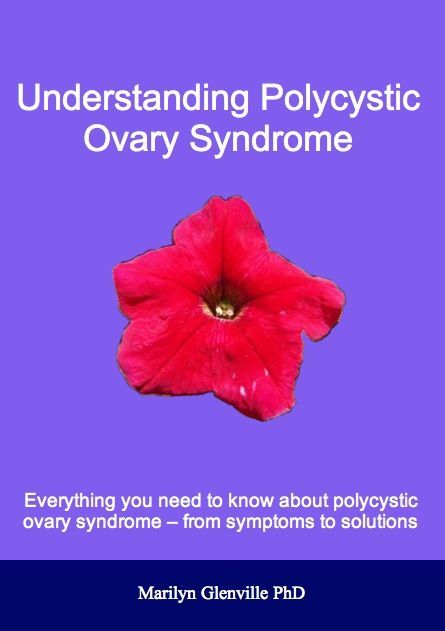£7.94
In stock
"Polycystic ovary syndrome is something quite different to suffering from ovarian cysts, which are discussed in detail in the Ovarian Cyst e-book. Polycystic ovaries are ovaries that are actually covered with very small follicles in which the egg develops.
What is polycystic ovary syndrome?
"In each menstrual cycle, follicles grow on the ovaries. Within those follicles eggs develop, one of which will reach maturity faster than the others and be released into the fallopian tubes. This is known as ovulation. The remaining follicles (sometimes hundreds) will degenerate. In the case of polycystic ovaries, however, the ovaries are much larger than normal, and there are a series of undeveloped follicles that appear in clumps, rather like a bunch of grapes. Polycystic ovaries are not particularly troublesome and in many cases they will not even affect your fertility. Where the problem starts, however, is when the cysts cause a hormonal imbalance, leading to a series of other symptoms. These symptoms are the difference between suffering from PCOS and from polycystic ovaries.
"So a woman can have polycystic ovaries without having PCOS but all women with PCOS will have polycystic ovaries.
What symptoms could you experience?
"With the most extreme form of PCOS, you would tend to be overweight, have no or very few periods, be prone to acne, grow unusually heavy body hair, often on the face, breasts and inside of the legs, and be susceptible to mood swings. And with this can come problems with fertility and often-recurrent miscarriages. Women with PCOS may be seven times more likely to develop diabetes because..."
What is polycystic ovary syndrome?
"In each menstrual cycle, follicles grow on the ovaries. Within those follicles eggs develop, one of which will reach maturity faster than the others and be released into the fallopian tubes. This is known as ovulation. The remaining follicles (sometimes hundreds) will degenerate. In the case of polycystic ovaries, however, the ovaries are much larger than normal, and there are a series of undeveloped follicles that appear in clumps, rather like a bunch of grapes. Polycystic ovaries are not particularly troublesome and in many cases they will not even affect your fertility. Where the problem starts, however, is when the cysts cause a hormonal imbalance, leading to a series of other symptoms. These symptoms are the difference between suffering from PCOS and from polycystic ovaries.
"So a woman can have polycystic ovaries without having PCOS but all women with PCOS will have polycystic ovaries.
What symptoms could you experience?
"With the most extreme form of PCOS, you would tend to be overweight, have no or very few periods, be prone to acne, grow unusually heavy body hair, often on the face, breasts and inside of the legs, and be susceptible to mood swings. And with this can come problems with fertility and often-recurrent miscarriages. Women with PCOS may be seven times more likely to develop diabetes because..."
REMEMBER:
When you order this e-book you will receive an extra 2 e-books ("The Foundation of Health" and "Using Natural Medicine") worth over £15 absolutely free.
| Polycystic Ovary Syndrome (PCOS) E-book | 1 |
| Polycystic Ovary Syndrome (PCOS) | 2 |
| Table of Contents | 3 |
| Disclaimer | 5 |
| Copyright | 5 |
| Polycystic Ovary Syndrome (PCOS) | 6 |
| What is polycystic ovary syndrome? | 6 |
| What symptoms could you experience? | 6 |
| How do you know if you have PCOS? | 6 |
| What causes polycystic ovary syndrome? | 7 |
| What treatment can you be offered by your doctor? | 7 |
| Drugs | 8 |
| The Contraceptive Pill | 8 |
| Clomiphene | 8 |
| Metformin | 8 |
| Surgical Techniques | 9 |
| Wedge Resection | 9 |
| Laparoscopic ovarian diathermy | 9 |
| The drawbacks of medical treatment | 9 |
| What natural treatment could be effective? | 10 |
| Dietary changes | 10 |
| Phytoestrogens | 11 |
| The importance of timing | 11 |
| Supplements | 14 |
| Chromium | 14 |
| Clare | 14 |
| B vitamins | 15 |
| Zinc | 15 |
| Magnesium | 15 |
| Co-Enzyme Q10 | 16 |
| Garcinia cambogia | 16 |
| Herbs | 17 |
| Agnus castus (Vitex/chastetree berry) | 17 |
| Black Cohosh (Cimicifuga racemosa) | 17 |
| False Unicorn (Chaemaelirium luteum) | 17 |
| White Peony (Paeonia lactiflora) | 17 |
| Saw Palmetto (Serenoa repens) | 17 |
| Milk Thistle (Silybum marianum) | 18 |
| Dandelion (Taraxacum officinale) | 18 |
| Stress | 19 |
| Exercise | 20 |
| The Integrated Treatment Plan | 21 |
| If you do not want to get pregnant | 21 |
| If you are under 35 and want to get pregnant | 21 |
| If you are over 35 and want to get pregnant | 21 |
| Your Supplement Plan | 23 |
| Herbs | 23 |
| In Summary | 24 |
| The Next Step | 25 |
| Other E-books in this Series | 26 |
| References | 27 |
Quality Assured
This product has been awarded Dr Glenville's Exclusive Seal of Approval.

Click here to find out more. Seal of Approval
Guidance Support

If you would like more help and guidance please email one of our nutritionists, who will be pleased to recommend an appropriate course of action for you, by clicking here.
Contact Us




